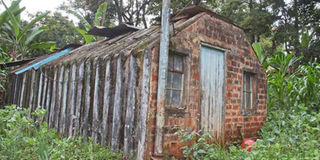History of pain under colonial rule still visible at Nyeri school

The house which used to be resided by the executioner at the Mweru colonial detention camp in Nyeri. PHOTO | JOSEPH KANYI | NATION MEDIA GROUP
What you need to know:
Those captured found themselves in camps, where they would be tortured until they confessed to crimes or offences, real or imaginary.
Hardcore detainees were tortured to death, while those who survived were left permanently disabled and impotent after they were castrated.
Surviving freedom fighters still speak of their experiences in low tones, as they dread the memories of the mistreatment they underwent.
Buried between towering trees and banana plants, the structures at Mweru High School on the outskirts of Nyeri town are testimony to the painful struggle for independence 56 years ago.
The school, about 11 kilometres from Mukurweini town, was once a concentration camp, with cells and torture chambers in pre-independent Kenya, where the Mau Mau freedom fighters were held.
DISABLED
The dark history enclosed in the old brick houses that have been repurposed into classrooms is that of the suffering the freedom fighters underwent at the hands of the British colonial officers.
For those who survived to tell the story, it was a harrowing experience that still haunts them, and they would rather not talk about it.
It was in this place that they were tortured with crude weapons after being arrested in the forest, which they used as their base to launch attacks on the colonial government.
Those captured found themselves in camps, where they would be tortured until they confessed to crimes or offences, real or imaginary.
Hardcore detainees were tortured to death, while those who survived were left permanently disabled and impotent after they were castrated.
Surviving freedom fighters still speak of their experiences in low tones, as they dread the memories of the mistreatment they underwent under the colonialists and their African lackeys.
At the school, which sits on 21 acres, the physical structures of the camp still stand — the cells, torture chambers, and the main office, which are currently being used by the school head.
The torture chambers — three dilapidated brick buildings — were fortified with barbed wire on the roof to prevent the inmates from escaping.
VIOLENCE
They were small, single-room structures with a small opening on the door for the colonialists to communicate with the detainees. They had no ventilation or lighting since the detainees were not allowed to talk to anyone.
A brick kiln still stands where the detainees were forced to the make bricks that were used to build the structures in the compound is still standing.
Those who had the misfortune of being arrested have different stories to tell, but violence is a common theme in their narrations.
Mr Wambugu wa Nyingi was among the last detainees to leave the camp after being held in different camps, including in Hola, Tana River County.
He recalls that beatings and flogging were common, as the hapless victims were subjected to forced hard labour. Many succumbed to the injuries.
“Men would be subjected to the worst forms of torture, especially on their private parts,” says Mr Anthony Maina, the curator.
A tribute on one of the torture chambers captures the freedom fighters’ contribution in the war for independence. “They hated the injustice, they took the oath and went to the forest. They were detained, harassed and tortured; they died in here for our freedom,” it reads.
CASTRATED
Those perceived as hardcore Mau Mau were the ones who got castrated as the colonialists sought to force information out of them.
The camp also served as the last stage of vetting and “cleansing” for those returning from other camps such as Manyani and Hola to ensure that they co-operated.
“They locked me up in the room. It was dark. Sometimes they would pass me food through a space under the door,” recalls Mr Wambugu wa Ngunyi.
“For the three months I was in there. I had only a blanket to cover myself with on cold nights and bucket that served as a toilet in the corner of the room. And I did not talk to anyone. They later dropped me off at Gatitu to go home,” he says.
Retired President Daniel Moi visited the camp twice, going by his signatures on the visitor’s book. Former President Mwai Kibaki and a number of senior government officials have also visited the place.
Is there any site you want us to feature? Write an e-mail to [email protected]





